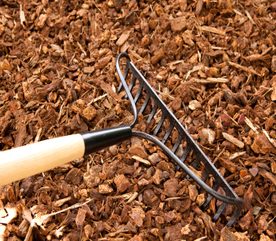Garden Tips: Removing Leaves from Your Landscape
Raking may not be everyone’s favourite task but it will benefit your landscape and garden in the long run. It’s also a physically demanding chore that takes a lot of you and your body! Whether you like it or not, it must be done. Of course, there are alternative methods you can use to help ease the burden of raking.

Do you Have to Rake?
Yes, you do. Fallen leaves block light to grass, flowers, and even moss, so if you want a nice lawn or pretty flowerbeds, you need to rearrange nature’s autumn fallout.Many gardeners regard fallen leaves as a blessing because they do such a good job of improving the soil when shredded and used as mulch or set aside to slowly ripen into compost. Save your raking chores for a clear, not-very-windy day, and perhaps you will even enjoy the job.
Design a Leaf-Eating Landscape
Design a leaf-eating landscape. Create beds near deciduous trees that can be filled with small shrubs and other plants that appreciate deep, natural mulch.When the leaves fall, simply rake them into the beds after running over them once with your mower.
Use a Blower
Use a blower to remove leaves from decks, patios, and driveways.Wet leaves can be dangerously slippery underfoot.
Avoid Back Fatigue
Avoid back fatigue twisting the trunk of your body, rake leaves straight back and walk backward as you pull the rake with you.
Rake ’em Wet or Rake ’em Dry
Rake ’em wet or rake ’em dry.Wet leaves are heavier than dry ones, but they tend to stay put when raked into a pile.Wait to rake until the leaves are dry if you have allergies, because wet leaves can be a breeding ground for molds and mildews that make allergy sufferers miserable.
Got Pines?
Rake the needles as soon as they fall, before they get mixed with leaves, which usually fall later. Pack them into garbage bags and keep them in a dry place until you need more mulch for azaleas, blueberries, or other plants that like acidic soil conditions.
Mow over Leaves
Mow over leaves on the lawn to collect them in the bagging attachment. High-nitrogen grass clippings combined with shredded, high-carbon leaves form a particularly good composting material. If you prepare planting space for spring flowers or vegetables in the fall, shredded leaves mixed with grass clippings make great winter mulch. When you rake back the mulch in spring, the soil will be ready to plant.
If you Have a Mulching Mower…
If you have a mulching mower, use it for grasscycling clippings back into the lawn, but don’t expect the lawn to absorb a large supply of shredded leaves. Instead, rake or blow your leaves to a paved surface and mow over them several times to chop them up.They will then be ready to use as mulch, or you can put them in a separate pile to decompose.
If you don’t Have a Bagger
If you don’t have a bagger on your mower, mow in square sections with the discharge chute pointed toward the middle of the square. It will toss the shredded leaves into a row so they will be easier to gather up and move.
Bundle Them Up
Bundle them up.To save your back, don’t pick up the leaves to put them in a wheelbarrow to transport them to the curb or leaf pile. Instead, rake them onto an old sheet or plastic tablecloth laid on the ground, gather up the four corners, and drag the bundle to the curb or leaf pile.
Set Aside Sticks
Set aside sticks and use them as fireplace kindling. If you have a large yard, a brush pile kept in an out-of-the-way place can become a shelter for chipmunks, birds, or other homeless wildlife.



